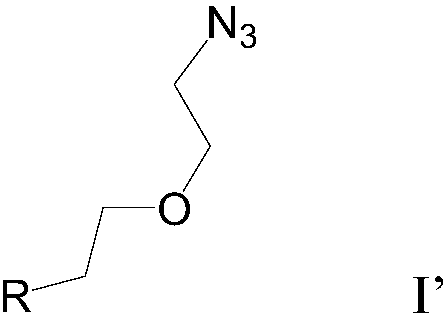Novel glycosyl compound and biological antibacterial material constructed with same
A technology of antibacterial materials and compounds, applied in the field of pharmacy, can solve the problems of difficulty in eradicating bacteria, improper dosage, and promoting bacteria.
- Summary
- Abstract
- Description
- Claims
- Application Information
AI Technical Summary
Problems solved by technology
Method used
Image
Examples
Embodiment 1
[0134] Embodiment 1. Preparation of two-dimensional molybdenum sulfide material
[0135] As described in "Materials and Methods", according to the method reported in the existing literature (Angew.Chem.Int.Ed. 2011,50,10839), using natural molybdenum sulfide powder as raw material, by controlling the ultrasonic temperature, time, power, etc. Operation means, and finally prepare molybdenum disulfide material with uniform size through centrifugation and freezing.
Embodiment 2
[0136] Example 2. Synthesis of Glycosyl Compounds
[0137] The overall synthesis process of the glycosyl compound of the present invention is as follows: first, three azide sugar ligands such as galactose, fucose, and maltose are synthesized by glycosylation; at the same time, rings with disulfide bonds are synthesized by amidation Octyne ligand; finally, the azido sugar ligand and cyclooctyne ligand synthesized above were combined with non-copper click chemistry to finally synthesize three glycosyl compounds with different glycoforms.
[0138] The specific synthesis situation is as follows:
[0139]
[0140] Scheme S1.
[0141] Synthesis of 3: To 1 (55 mg, 0.19 mmol) (Bioconjugate Chem.2012, 23, 1680-1686) in CH 2 Cl 2 To the solution as solvent was added EDCl (69.2 mg, 0.23 mmol) and HOBt (31.1 mg, 0.23 mmol), followed by 2 (60.0 mg, 0.29 mmol). The mixture was stirred under nitrogen for 12 hours. The resulting mixture was treated with CH 2 Cl 2 Dilute and wash wit...
Embodiment 3
[0154] Example 3. Self-assembly of composite nanomaterials carrying fluorophores or antibiotic drugs
[0155] As described in "Materials and Methods", the ultrasonic assembly of glycosyl compounds and 2D nanomaterials in solution is based on the ability of the modified disulfide bond groups on the glycosyl compounds to coordinate with the surface of the 2D molybdenum sulfide material , followed by centrifugation to obtain composite nanomaterials of surface-modified glycosyl compounds. Then further use the method of physical encapsulation to assemble the fluorophore or antibiotic into the sugar-based composite nanomaterial, and quantify the concentration of the encapsulated fluorophore or antibiotic by means of centrifugation, ultraviolet detection, etc., and finally assemble to form a fluorophore or antibiotic Composite nanomaterials for antibiotic drugs.
PUM
 Login to View More
Login to View More Abstract
Description
Claims
Application Information
 Login to View More
Login to View More - R&D
- Intellectual Property
- Life Sciences
- Materials
- Tech Scout
- Unparalleled Data Quality
- Higher Quality Content
- 60% Fewer Hallucinations
Browse by: Latest US Patents, China's latest patents, Technical Efficacy Thesaurus, Application Domain, Technology Topic, Popular Technical Reports.
© 2025 PatSnap. All rights reserved.Legal|Privacy policy|Modern Slavery Act Transparency Statement|Sitemap|About US| Contact US: help@patsnap.com



